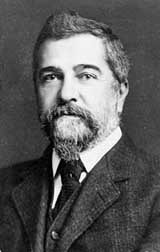
St. George’s has three Tiffany windows though one is a double window with two distinct scenes, one below the gallery level and the other at gallery level. All were installed in the Church during the years 1912-1917. Tiffany’s significance in art was that he was the creator of an American glass.
Louis Comfort Tiffany (1848-1933) was the son of Charles Lewis Tiffany, founder of Tiffany and Company (jewelry and silverware) in New York City. Louis maintained close ties with the family firm and he became Artistic Director of Tiffany & Co. after his father’s death in 1902. His first artistic training was as a painter, studying under George Inness and Samuel Colman in New York City and Léon Bailly in Paris. However, he had shortcomings as a painter and moved to the applied arts and started a decorating firm in the 1880’s.
In 1865, Tiffany traveled to Europe and in London he visited the Victoria and Albert Museum, whose extensive collection of Roman and Syrian glass made a deep impression on him. He admired the coloration of medieval glass and was convinced that the quality of contemporary glass could be improved upon. Tiffany wanted the glass itself to transmit texture and rich colors.
In the 1870’s, he began experimentation on glass, renting space in the commercial glass houses in the New York area. He won his first commission in 1876 for the Church of the Sacred Heart in New York.
He lived at the right time to introduce his windows into churches. The number of churches under construction in one year alone 1875 (4,000) provided possible commissions. The highpoint of Tiffany window production was between 1890 and 1920 when the ecclesiological movement from England desired to revive medieval art and architecture in the Church. He also became disenchanted with interior design since he failed to win recognition in this field.
What makes Tiffany windows Tiffanies? Much of the success of Tiffany lay in his use of glass and special techniques and his ability to attract designers. All designs were personally reviewed by him. In addition, he helped to introduce landscape and floral panels into Churches.
Tiffany experimented with novel types of materials, achieving a more varied palette with richer hues and greater density. Tiffany and his rival John LaFarge working independently explored the pictorial, coloristic, and textural qualities of stained glass in new and daring ways that completely changed the look of the medium. By 1881, each artist had patented an opalescent glass, which has a milky, opaque, and sometimes rainbow-hued appearance when light shines through it. Tiffany called his brand Favrile Glass and was a key part of his stained glass windows since the color was embedded or ingrained in the glass. It was a uniquely American phenomenon that proved to be among the most important advances in decorative windows .
In 1885, he created his own company, Tiffany Glass Company to assemble the windows, using glass purchased from various manufacturers. He gathered a competent set of designers, many of whom worked for him for a lifetime. By the end of the 1880’s it was the largest stained glass studio in the nation. Eight years later, he started his own glasshouse in Corona, Queens, New York. Tiffany hired Arthur Nash, an experienced English glassblower, to run the Corona factory. Originally called the Tiffany Glass and Decorating Company, it became Tiffany Furnaces in 1902. (Tiffany Studios was the related company producing stained glass windows). It was Nash who developed the formulas for creating the glass. In addition to fabricating the glass for Tiffany’s stained glass windows, this company produced blown glass vessels.
Tiffany received the recognition he sought after the 1893 Columbian Exposition. His exhibit, mostly a lavishly gilded and ornate Byzantine chapel drew hoards of visitors and brought accolades from critics.
